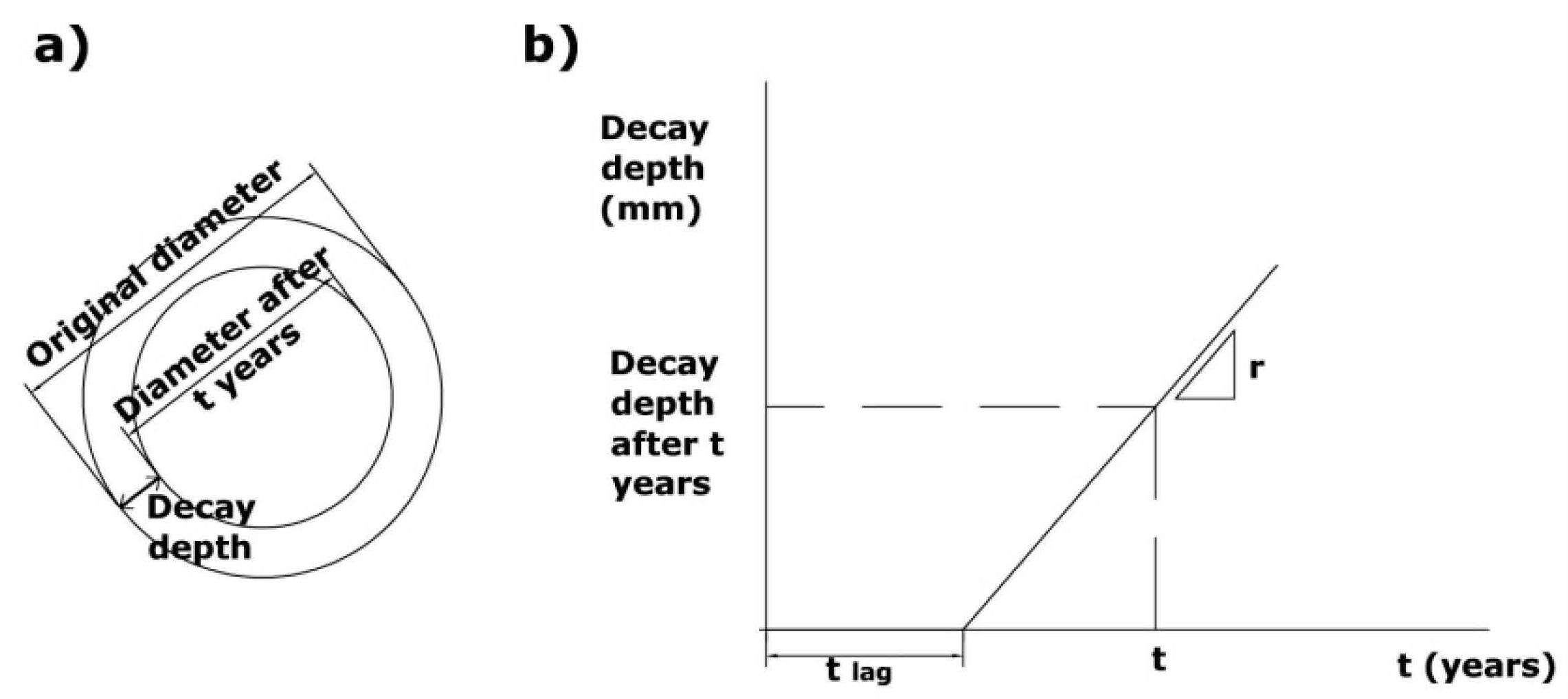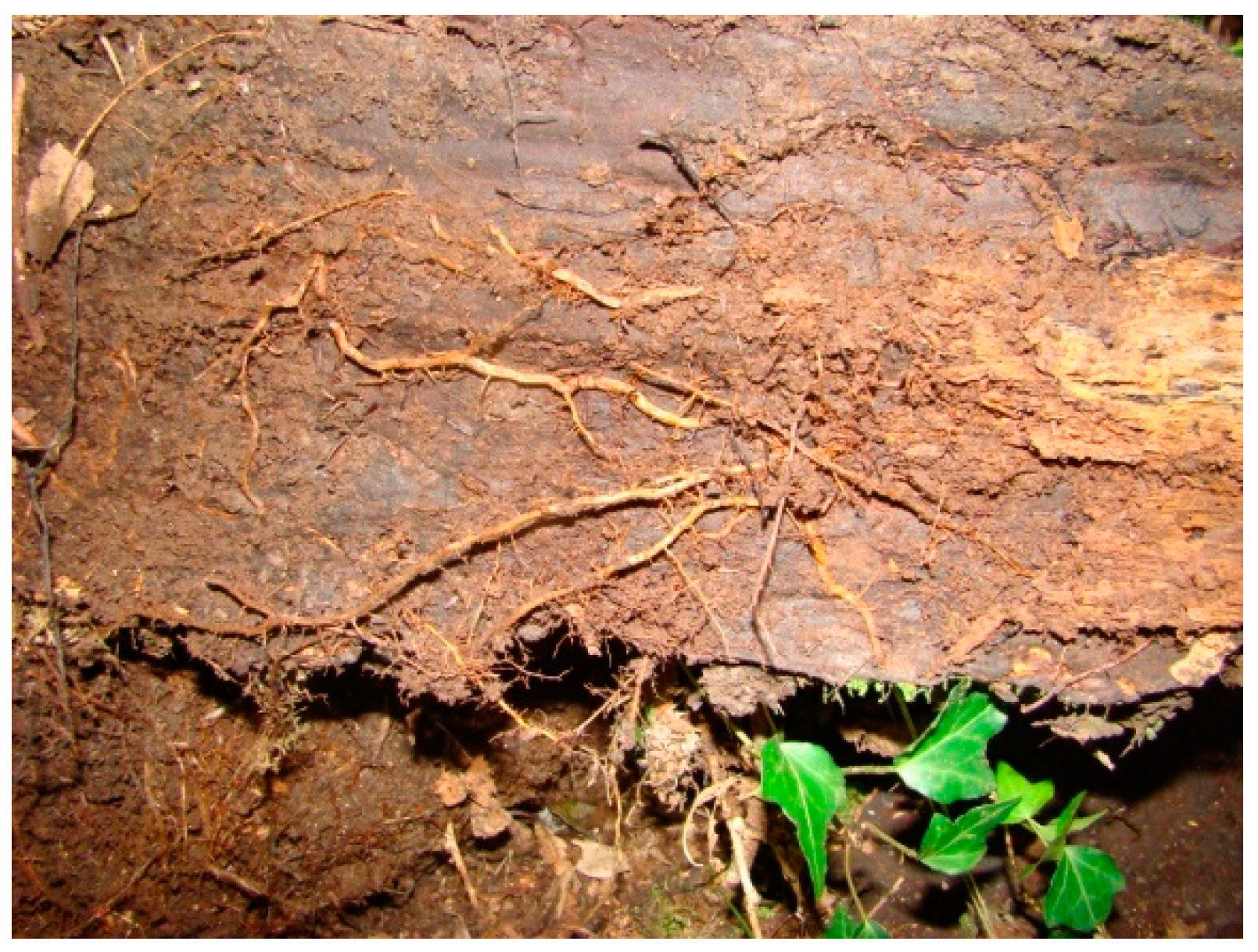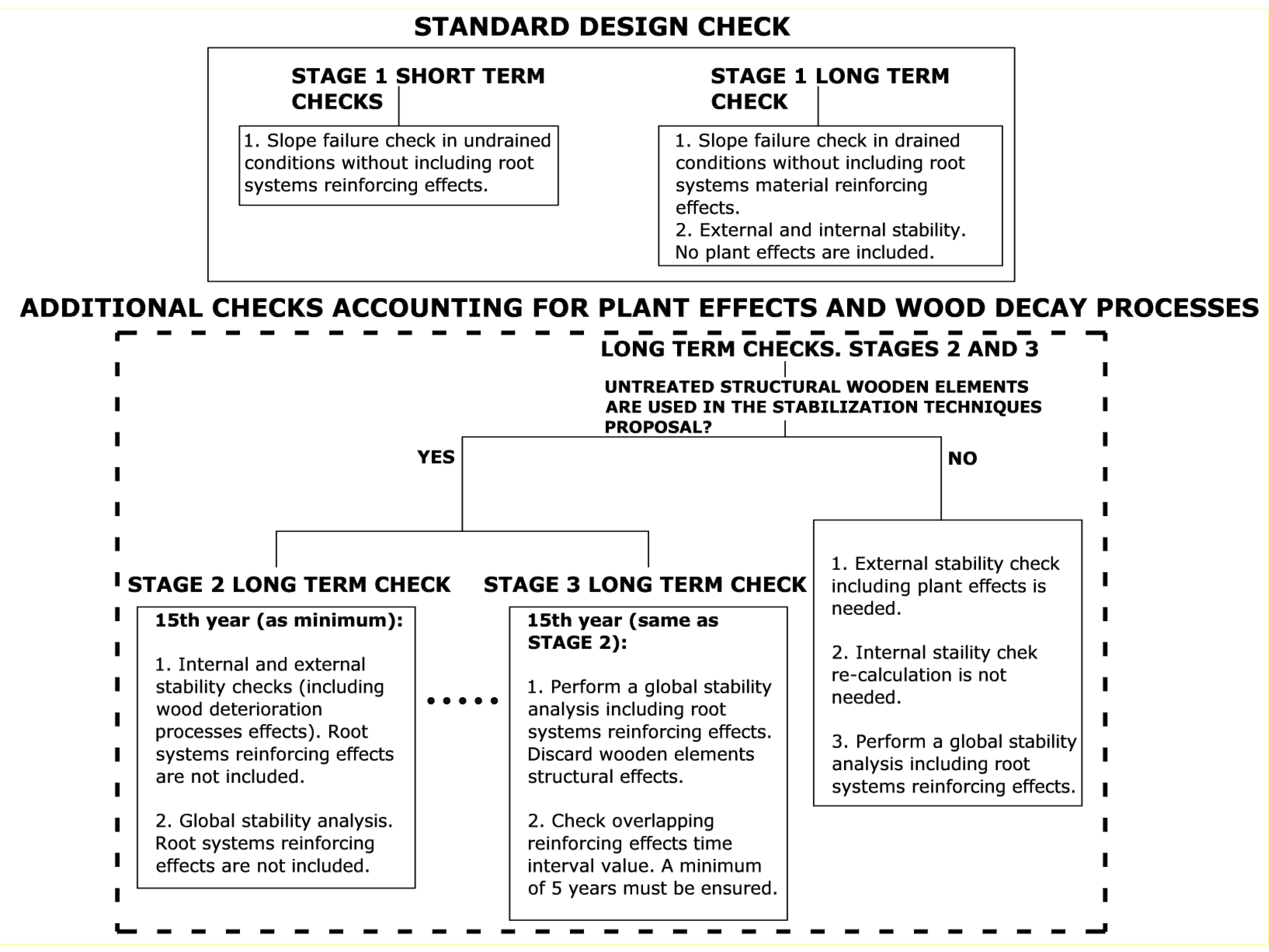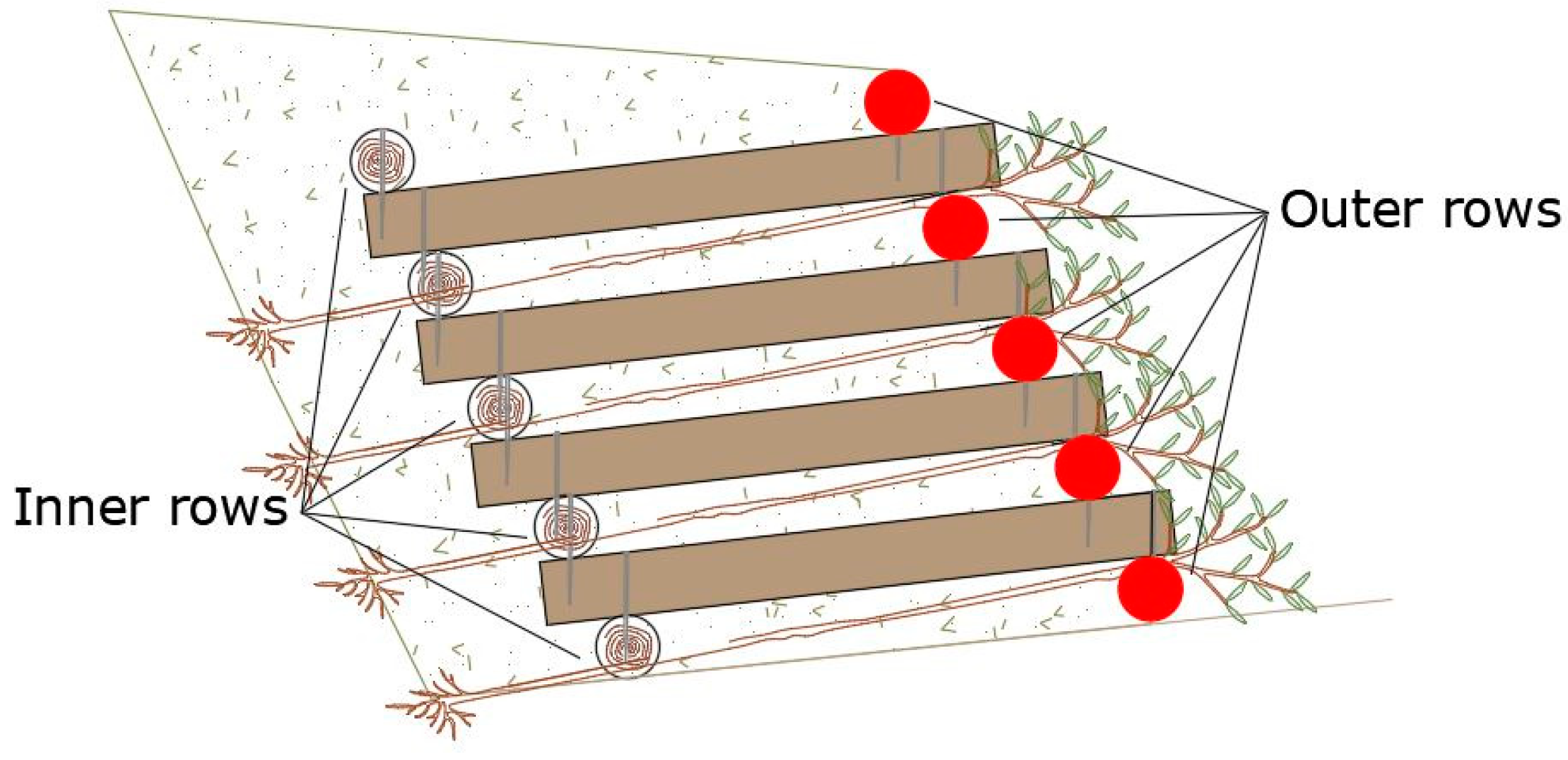A Novel Integrated Design Methodology for Nature-Based Solutions and Soil and Water Bioengineering Interventions: The Tardio&Mickovski Methodology
Abstract
1. Introduction
- (a)
- Definition of a temporal framework of milestone stability checks for both short- and long-term analysis.
- (b)
- Effects of inert material (wood) deterioration processes on stability checks.
- (c)
- Assessment of reinforcing and stabilizing effects of the root systems of developing vegetation. Incorporation of this reinforcement in the long-term stability checks of SWB works.
- (d)
- Integration of the preceding processes throughout the service life of SWB works.
2. Theoretical Background
2.1. Wood Deterioration Processes
2.2. Reinforcement Effect Due to Root Systems
2.3. External and Internal Stability
2.4. Stages and Time Milestones of the Tardio&Mickovski Methodology
- (a)
- Sorolla et al. [74], where 23 log crib walls were analyzed. Information regarding vegetation and log crib wall deterioration processes was collected.
- (b)
- Castillo-Serrabasa [75], where 12 log crib walls were analyzed. Information regarding vegetation and logs deterioration processes was collected.
- (c)
- Case studies analyzed during the Ecomed project [14].
- (d)
- Bioengineering works analyzed in Wolff Kettenhuber et al. [76].
- (e)
- Time framework included in Fernandes and Guiomar [77].
- (a)
- In STAGE 2, an adequate mechanical behavior is ensured for, at least, the first 15 years of the SWB work service life. This implies that the residual mechanical resistance of the bioengineered structures will always be achieved between 15 and 50 years of service life of the SWB work (depending on the species of wood used and the conditions of the intervention area). This time milestone, at which the structure will perform a residual mechanical reinforcing effect, can be calculated by using the Leicester et al. model [10].
- (b)
- In STAGE 3, the overall stability check is performed at the same time milestone as in STAGE 2. This ensures an overlap of time in which there is collaboration between the wooden structure (still mechanically stable in STAGE 2) and the vegetation reinforcing effects (even if this overlap of effects is not taken into account so that the design errs on the side of safety). From the STAGE 3 time milestone until the moment at which (theoretically and without taking into account plant reinforcing effects) the structure will reach its residual strength and eventually fail, there will be a time interval during which both reinforcing effects, those coming from the structure and those coming from the vegetation, will continue to overlap. A minimum value of 5 years is proposed for this extra time interval (after STAGE 3 time milestone) in which an overlapping reinforcing effect between the structures and vegetation takes place. Therefore, according to the preceding time framework, the structure’s residual strength must be reached at t = 20 years as minimum. In this way, the residual risk is minimized when adopting the SWB approach.
3. Methodology Validation—Case Study
3.1. Site and SWB Work Information
3.2. STAGE 1: Stability Checks
3.3. STAGE 2: Analysis of Wood Deterioration Processes
3.4. STAGE 2: Stability Checks
3.5. STAGE 3: Stability Checks
- (a)
- Mean vegetation height = 3.5 m
- (b)
- Mean vegetation diameter = 0.12 m
4. Discussion
5. Conclusions
Author Contributions
Funding
Institutional Review Board Statement
Informed Consent Statement
Data Availability Statement
Acknowledgments
Conflicts of Interest
References
- Schiechtl, H.M. Bioengineering for Land Reclamation and Conservation; Univ. of Alberta Press: Edmonton, AB, Canada, 1980. [Google Scholar]
- EFIB. European Guidelines for Soil and Water Bioengineering. European Federation for Soil and Water Bioengineering, 2015. Available online: https://boku.ac.at/baunat/iblb/efib-european-federation-of-soil-bioengineering (accessed on 4 February 2020).
- Schiechtl, H.M.; Stern, R. Ground Bioengineering Techniques: For Slope Protection and Erosion Control; Wiley-Blackwell: Hoboken, NJ, USA, 1996; ISBN 10: 0632040610/13: 9780632040612. [Google Scholar]
- Seddon, N.; Smith, A.; Smith, P.; Key, I.; Chausson, A.; Girardin, C.; Turner, B. Getting the message right on nature-based solutions to climate change. Glob. Change Biol. 2021, 27, 1518–1546. [Google Scholar] [CrossRef] [PubMed]
- EU. Communication from the Commission to the European Parliament, the Council, the European Economic and Social Committee and the Committee of the Regions Green Infrastructure (GI)—Enhancing Europe’s Natural Capital, /* COM/ 2013/0249 final */. 2013. Available online: https://eur-lex.europa.eu/legal-content/EN/TXT/?uri=CELEX:52013DC0249 (accessed on 9 January 2023).
- Preti, F.; Dani, A.; Noto, L.V.; Arnone, E. On the Leonardo’s rule for the assessment of root profile. Ecol. Eng. 2022, 179, 106620. [Google Scholar] [CrossRef]
- Debele, S.E.; Kumar, P.; Sahani, J.; Marti-Cardona, B.; Mickovski, S.B.; Leo, L.S.; Porcù, F.; Bertini, F.; Montesi, D.; Vojinovic, Z.; et al. Nature-based solutions for hydro-meteorological hazards: Revised concepts, classification schemes and databases. Environ. Res. 2019, 179 Pt B, 108799. [Google Scholar] [CrossRef]
- Mickovski, S.B.; Gonzalez-Ollauri, A.; Thomson, C.S.; Gallagher, C.E.; Tardio, G. Assessment of the Sustainability Performance of Eco-Engineering Measures in the Mediterranean Region. Land 2022, 11, 533. [Google Scholar] [CrossRef]
- Bischetti, G.B.; Chiaradia, E.A.; D’Agostino, V.; Simonato, T. Quantifying the effect of brush layering on slope stability. Ecol. Eng. 2009, 36, 258–264. [Google Scholar] [CrossRef]
- Leicester, R.H.; Wang, C.-H.; Ngyen, M.N.; Thornton, J.D.; Johnson, G.; Gardner, D.; Foliente, G.C.; Mackenzie, C. An Engineering Model for the Decay in Wood in Ground Contact; Document No IRGWP 03-20260; International Research Group on Wood Protection: Stockholm, Sweden, 2003. [Google Scholar]
- Bischetti, G.B.; De Cesare, G.; Mickovski, S.B.; Rauch, H.P.; Schwarz, M.; Stangl, R. Design and temporal issues in Soil Bioengineering structures for the stabilisation of shallow soil movements. Ecol. Eng. 2021, 169, 106309. [Google Scholar] [CrossRef]
- Gonzalez Ollauri, A.; Mickovski, S.B.; Anderson, C.; Debele, S.; Emmanuel, R.; Kumar, P.; Loupis, M.; Ommer, J.; Pfeiffer, J.; Panga, D.; et al. A Nature-based solution selection framework: Criteria and processes for addressing hydro-meteorological hazards at open-air laboratories across Europe. J. Environ. Manag. 2023, 331, 117183. [Google Scholar] [CrossRef]
- Kumar, P.; Debele, S.E.; Sahani, J.; Rawat, N.; Marti-Cardona, B.; Alfieri, S.M.; Basu, B.; Basu, A.S.; Bowyer, P.; Charizopoulos, N.; et al. Nature-based solutions efficiency evaluation against natural hazards: Modelling methods, advantages and limitations. Sci. Total Environ. 2021, 784, 147058. [Google Scholar] [CrossRef]
- García-Rodríguez, J.L.; Sangalli, P.; Tardio, G.; Mickovski, S.; Fernandes, J.; Gimenez, M. (Eds.) Specialization Process for the Bioengineering Sector in the Mediterranean Environment. ECOMED Project; Part II. Protocols and Case Studies; Fundación Conde del Valle de Salazar: Madrid, Spain, 2019; ISBN 978-84-96442-89-4. [Google Scholar]
- Kumar, P.; Debele, S.E.; Sahani, J.; Rawat, N.; Marti-Cardona, B.; Alfieri, S.M.; Basu, B.; Basu, A.S.; Bowyer, P.; Charizopoulos, N.; et al. An overview of monitoring methods for assessing the performance of nature-based solutions against natural hazards. Earth Sci. Rev. 2021, 217, 103603. [Google Scholar] [CrossRef]
- Rey, F.; Bifulco, C.; Bischetti, G.B.; Bourrier, F.; De Cesare, G.; Florineth, F.; Graf, F.; Marden, M.; Mickovski, S.B.; Phillips, C.; et al. Soil and water bioengineering: Practice and research needs for reconciling natural hazard control and ecological restoration. Sci. Total Environ. 2019, 648, 1210–1218. [Google Scholar] [CrossRef]
- Tardio, G.; Mickovski, S.B. Implementation of eco-engineering design into existing slope stability design practices. J. Ecol. Eng. 2016, 92, 138–147. [Google Scholar] [CrossRef]
- Stokes, A.; Douglas, G.B.; Fourcaud, T.; Giadrossich, F.; Gillies, C.; Hubble, T.; Kim, J.H.; Loades, K.W.; Mao, Z.; McIvor, I.R.; et al. Ecological mitigation of hillslope instability: Ten key issues facing researchers and practitioners. Plant Soil 2014, 377, 1–23. [Google Scholar] [CrossRef]
- Mickovski, S. Resilient design of landslip prevention measures: A case study. Proc. ICE—Forensic Eng. 2015, 168, 96–106. [Google Scholar] [CrossRef]
- Duncan, J.M.; Wright, S.G. Soil Strength and Slope Stability; John Wiley and Sons, Inc.: Hoboken, NJ, USA, 2005. [Google Scholar]
- Roque, A.J.; Paleologos, E.K.; O’Kelly, B.C.; Tang, A.M.; Reddy, K.R.; Vitone, C.; Mohamed, A.M.O.; Koda, E.; Goli, V.S.N.S.; Vieira, C.S.; et al. Sustainable environmental geotechnics practices for a green econom. Environ. Geotech. 2022, 9, 68–84. [Google Scholar] [CrossRef]
- Eaton, R.A.; Hale, M.D.C. Natural durability. In Wood Decay, Pests and Protection, 1st ed.; Chapman & Hall: London, UK, 1993; pp. 311–318. [Google Scholar]
- Johnson, G.C.; Thornton, J.D.; Trajstman, A.C.; Cookson, L.J. Comparative in-ground natural durability of white and black cypress pines (Callitris glaucophylla and C. endlicheri). Aust. For. 2006, 69, 243–247. [Google Scholar] [CrossRef]
- UNE-EN 350; Durability of Wood and Wood-Based Products—Testing and Classification of the Durability to Biological Agents of Wood and Wood-Based Materials. European Committee for Standardisation (CEN): Brussels, Belgium, 2016.
- Niklewski, J.; van Niekerk, P.B.; Brischke, C.; Frühwald Hansson, E. Evaluation of Moisture and Decay Models for a New Design Framework for Decay Prediction of Wood. Forests 2021, 12, 721. [Google Scholar] [CrossRef]
- Boddy, L.; Rayner, A.D.M. Origins of decay in living deciduous trees: The role of the moisture content and re-appraisal of the expanded concept of tree decay. New Phytol. 1983, 94, 623–641. [Google Scholar] [CrossRef]
- Wang, C.H.; Leicester, R.H.; Foliente, G.C.; Nguyen, M.N. Wood Service Life Design Guide; Forest and Wood Products Australia Limited: Melbourne, Australia, 2007; 115p. [Google Scholar]
- EN 1995-1-1:2004/A1:2008; Eurocode 5: Design of Timber Structures—Part 1-1: General—Common Rules and Rules for Buildings/Incl Amendment A1. European Committee for Standardization: Brussels, Belgium, 2008.
- De Vries, P.A. Quality and Strength Characterisation of Small Diameter Larch (Larix kaempferi (LMAB.) CARRR.); Report C4-98-01; Delft University: Delft, The Netherlands, 1998. [Google Scholar]
- Ranta-Maunus, A.; Saarelainen, U.; Boren, H. Strength of small-diameter round wood. In Proceedings of the CIB W18 Meeting in Savonlinna, Savonlinna, Finland, 12–14 August 1998. Paper 31-6-3, 10p. [Google Scholar]
- Pollen, N.; Simon, A. Estimating the mechanical effects of riparian vegetation on stream bank stability using a fiber bundle model. Water Resour. Res. 2005, 41, W07025. [Google Scholar] [CrossRef]
- Norris, J.E.; Stokes, A.; Mickovski, S.B.; Cammeraat, E.; Van Beek, R.; Nicoll, B.C.; Achim, A. (Eds.) Slope Stability and Erosion Control: Ecotechnological Solutions; Springer: Berlin/Heidelberg, Germany, 2008; Volume VI, 290p. [Google Scholar]
- Stokes, A.; Atger, C.; Bengough, A.; Fourcaud, T.; Sidle, R. Desirable plant root traits for protecting natural and engineered slopes against landslides. Plant Soil. 2009, 324, 1–30. [Google Scholar] [CrossRef]
- Preti, F.; Giadrossich, F. Root reinforcement and bioengineering stabilisation by Spanish broom. Hydrol. Earth Syst. Sci. 2009, 13, 1713–1726. [Google Scholar] [CrossRef]
- Schwarz, M.; Cohen, D.; Or, D. Root–soil mechanical interactions during pullout and failure of root bundles. J. Geophys. Res. Atmos. 2010, 115. [Google Scholar] [CrossRef]
- Fan, C.C. A displacement-based model for estimating the shear resistance of root-permeated soils. Plant Soil 2012, 355, 103–119. [Google Scholar] [CrossRef]
- Bourrier, F.; Kneib, F.; Chareyre, B.; Fourcaud, T. Discrete modelling of granular soils reinforcement by plant roots. Ecol. Eng. 2013, 61 Pt C, 646–657. [Google Scholar] [CrossRef]
- Schwarz, M.; Cohen, D.; Giadrossich, F. Quantification of Compressed rooted soil. JGR Earth Surf. 2015, 120, 2103–2120. [Google Scholar] [CrossRef]
- Tardio, G.; Mickovski, S.B. Method for synchronisation of soil and root behaviour for assessment of stability of vegetated slopes. J. Ecol. Eng. 2015, 82, 222–230. [Google Scholar] [CrossRef]
- Coppin, N.J.; Richards, I.G. Use of Vegetation in Civil Engineering; CIRIA Butterworths Construction Industry Research and Information Association: London, UK, 2007. [Google Scholar]
- Danjon, F.; Barker, D.H.; Drexhage, M.; Stokes, A. Using three dimensional plant root architecture in models of shallow-slope stability. Ann. Bot. 2007, 101, 1281–1293. [Google Scholar] [CrossRef] [PubMed]
- Mickovski, S.B.; van Beek, L.P.H.; Salin, F. Uprooting resistance of vetiver grass (Vetiveria zizanioides). Plant Soil 2005, 278, 33–41. [Google Scholar] [CrossRef]
- Thomas, R.E.; Pollen-Bankhead, N. Modelling root reinforcement with a fibre-bundle model and Monte Carlo simulation. Ecol. Eng. 2010, 36, 47–61. [Google Scholar] [CrossRef]
- Gonzalez-Ollauri, A.; Mickovski, S.B. The effect of willow (Salix sp.) on soil moisture and matric suction at a slope scale. Sustainability 2020, 12, 9789. [Google Scholar] [CrossRef]
- Greenwood, J.R. SLIP4EX—A program for routine slope stability analysis to include the effects of vegetation, reinforcement and hydrological changes. J. Geotech. Geol. Eng. 2006, 24, 449–465. [Google Scholar] [CrossRef]
- Dupuy, L.; Fourcaud, T.; Lac, P.; Stokes, A. A generic 3d finite element model of tree anchorage integrating soil mechanics and real root system architecture. Am. J. Bot. 2007, 94, 1506–1514. [Google Scholar] [CrossRef] [PubMed]
- Wu, T.H. Investigation of landslides on Prince of Wales Island. Geotechnical Engineering Report 5; Civil Engineering Department, Ohio State University: Columbus, OH, USA, 1976. [Google Scholar]
- Gray, D.H.; Leiser, A.T. Biotechnical Slope Protection and Erosion Control; Van Nostrand Reinhold: New York, NY, USA, 1982. [Google Scholar]
- Ekanayake, J.C.; Marden, M.; Watson, A.J.; Rowa, D. Tree roots and slope stability: A comparison between Pinus radiata and kanuka. N. Z. J. For. Sci. 1997, 27, 216–233. [Google Scholar]
- Gray, D.H.; Sotir, R.B. Biotechnical and Eco-Engineering Slope Stabilization; Wiley: New York, NY, USA, 1996; p. 276. [Google Scholar]
- Chok, Y.H.; Kaggwa, W.S.; Jaksa, M.B.; Griffiths, D.V. Modelling the effects of vegetation on the stability of slopes. In Proceedings of the 9th Australia New Zealand Conference on Geomechanics, Auckland, New Zealand, 8–11 February 2004. [Google Scholar]
- Fourcaud, T.; Ji, J.N.; Zhang, Z.Q.; Stokes, A. Understanding the impact of root morphology on overturning mechanisms: A modelling approach. Ann. Bot. 2007, 101, 1267–1280. [Google Scholar] [CrossRef]
- Mickovski, S.B.; Stokes, A.; van Beek, L.P.H.; Ghestem, M.; Fourcaud, T. Simulation of direct shear tests on rooted and non-rooted soil using Finite Element analysis. Ecol. Eng. 2011, 37, 1523–1532. [Google Scholar] [CrossRef]
- Waldron, L.J. Shear resistance of root-permeated homogenous and stratified soil. Soil Sci. Soc. Am. J. 1977, 41, 843–849. [Google Scholar] [CrossRef]
- Ekanayake, J.; Phillips, C. Slope stability thresholds for vegetated hillslopes: A composite model. Can. Geotech. J. 2002, 39, 849–862. [Google Scholar] [CrossRef]
- Stokes, A.; Norris, J.E.; Van Beek, L.P.H.; Bogaard, T.; Cammeraat, E.; Mickovski, S.B.; Jenner, A.; Di Iorio, A.; Fourcaud, T. How vegetation reinforces soil on slopes. In Slope Stability and Erosion Control: Ecotechnological Solutions; Norris, J., Stokes, A., Mickovski, S., Cammeraat, E., Van Beek, R., Nicoll, B., Achim, A., Eds.; Springer: Dordrecht, The Netherlands, 2008; pp. 65–116. [Google Scholar]
- Mickovski, S.B.; Hallett, P.D.; Bengough, A.G.; Bransby, M.F.; Davies, M.C.R.; Sonnenberg, R. The effect of willow roots on the shear strength of soil. In Advances in GeoEcology 39: The Soils of Tomorrow, Proceedings of the 5th International Congress of the European Society for Soil Conservation, Palermo, Italy, 25–30 June 2007; Dazzi, C., Constantini, E., Eds.; Catena Verlag Gmbh: Reiskirchen, Germany, 2008; pp. 247–262. [Google Scholar]
- Mickovski, S.; Hallet, P.; Bransby, M.; Davis, M.; Sonnenberg, R.; Bengough, A. Mechanical reinforcement of soil by willow roots: Impacts of root properties and root failure mechanism. Soil Sci. Am. Soc. Agron. 2009, 73, 1276–1285. [Google Scholar] [CrossRef]
- Böhm, W. Methods of Studying Root Systems; Springer: Berlin/Heidelberg, Germany, 1979; p. 275. [Google Scholar]
- Van Noordwijk, M.; Brouwer, G.; Meijbroom, F.; Oliveira, M.R.G.; Bengough, A.G. Trench profile techniques and core break methods. In Root Methods: A Handbook; Smit, A.L., Ed.; Springer: Berlin/Heidelberg, Germany, 2000; pp. 211–233. [Google Scholar]
- Tardio, G.; González-Ollauri, A.; Mickovski, S.B. A non-invasive preferential root distribution analysis methodology from a slope stability approach. J. Ecol. Eng. 2016, 97, 46–57. [Google Scholar] [CrossRef]
- Giadrossich, F.; Schwarz, M.; Marden, M.; Marrosu, R.; Phillips, C. Bio-engineering traits of Pinus radiata D.Don: A case study in New Zealand. N. Z. J. For. Sci. 2020, 50, 17854. [Google Scholar] [CrossRef]
- Laio, F.; D’odorico, P.; Ridolfi, L. An analytical model to relate the vertical root distribution to climate and soil properties. Geophys. Res. Lett. 2006, 33, L18401. [Google Scholar] [CrossRef]
- Preti, F.; Dani, A.; Laio, F. Root profile assessment by means of hydrological, pedological and above-ground vegetation information for bio-engineering purposes. Ecol. Eng. 2010, 36, 305–316. [Google Scholar] [CrossRef]
- Francis, R.A.; Gurnell, A.M.; Petts, G.E.; Edwards, P.J. Survival and growth responses of Populus nigra, Salix elaeagnos and Alnus icana cuttings to varying levels of hydric stress. For. Ecol. Manag. 2005, 210, 291–301. [Google Scholar] [CrossRef]
- Schenk, H.J.; Jackson, R.B. Rooting depths, lateral root spreads and below-ground/above-ground allometries of plants in water-limited ecosystems. J. Ecol. 2002, 90, 480–494. [Google Scholar] [CrossRef]
- Waisel, Y.; Eshel, A.; Kafkafy, U. Plant Roots: The Hidden Half, 3rd ed.; Mercel Dekker Inc.: New York, NY, USA, 2002. [Google Scholar]
- Kutschera, L.; Lichtenegger, E. Wurzelatlas Mitteleuropäischer Waldbäume und Sträucher; Leopold Stocker Verlag: Graz, Austria; Stuttgart, Germany, 2002; 604p. [Google Scholar]
- Gonzalez-Ollauri, A.; Mickovski, S.B. Using the root spread information of pioneer plants to quantify their mitigation potential against shallow landslides and erosion intemperate humid climates. Ecol. Eng. 2016, 95, 302–315. [Google Scholar] [CrossRef]
- Cornelini, P.; Federico, C.; Pirrera, G. Arbusti Autoctoni Mediterranei per L’ingegneria Naturalistica. Primo Contributo Alla Morfometria Degli Apparati Radicali; n. 48; Azienda Regionale Foreste Demaniali Regione Siciliana, Collana Sicilia Foreste: Palermo, Italy, 2008. [Google Scholar]
- Pisano, M.; Cardile, G.; Ricciardi, A. Deterministic and probabilistic analyses of slopes reinforced with vegetation. In Geotechnical Research for Land Protection and Development; Lecture Notes in Civil Engineering, 40, Calvetti, F., Cotecchia, F., Galli, A., Jommi, C., Eds.; CNRIG, 2019; Springer: Cham, Switzerland, 2020. [Google Scholar]
- Schwarz, M. Wirkung der Vegetation in Biologischen Maßnahmen. In Stabilisierung Rutschender Hänge. FOBATEC Tagungsskript; Krättli, W., Schwarz, M., Eds.; Fachstelle Für Forstliche Bautechnik: Maienfeld, Switzerland, 2015; Available online: http://www.fobatec.ch/fileadmin/user_upload/customers/fobatec/09Unterlagen/Tagungsunterlagen/TagungsskriptRutschung151021.pdf (accessed on 9 January 2023).
- Walker, L.R.; Velázquez, E.; Shiels, A.B. Applying lessons from ecological succession to the restoration of landslides. Plant Soil 2009, 324, 157–161. [Google Scholar] [CrossRef]
- Sorolla, A.; Piera, E.; Mota- Freixas, B.; Sorolla Salvans, G.; Rueda, I.; Lochner Prats, A.; Unzeta, C. Improvement of the Plantation Success in a Crib Wall in a Mediterranean Hydro-Meteorological Risks Scenario—Practical Results. Sustainability 2021, 13, 11785. [Google Scholar] [CrossRef]
- Castillo-Serrabasa, J. Avaluació Funcional i Estructural Dels Entramats en AmbientsFluvials. Treball de Final de Máster. Master D’ecologia, Gestió i Restauració del Medi Natural; Facultat de Biologia, Universitat de Barcelona: Barcelona, Spain, 2022. [Google Scholar]
- Wolff Kettenhuber, P.L.W.; dos Santos Sousa RJoel Dewes, J.; Rauch, H.P.; Sutili, F.J.; Hörbinger, S. Performance assessment of a soil and water bioengineering work on the basis of the flora development and its associated ecosystem processes. Ecol. Eng. 2023, 186, 106840. [Google Scholar] [CrossRef]
- Fernandes, J.P.; Guiomar, N. Simulating the stabilization effect of soil bioengineering interventionsin Mediterranean environments using limit equilibrium stability models and combinations of plant species. Ecol. Eng. 2016, 88, 122–142. [Google Scholar] [CrossRef]
- Tardio, G.; Mickovski, S.B.; Sangalli, P. Incorporating the particularities of soil and water bioengineering works into a design methodology with monitoring feedback loops. In Proceedings of the Seventh International Conference on Structural Engineering, Mechanics and Computation (SMEC), Cape Town, South Africa, 2–4 September 2019. [Google Scholar]
- Mickovski, S.B. Re-Thinking Soil Bioengineering to Address Climate Change Challenges. Sustainability 2021, 13, 3338. [Google Scholar] [CrossRef]
- Zaimes, G.N.; Tardio, G.; Iakovoglou, V.; Gimenez, M.; Garcia-Rodriguez, J.L. New tools and approaches to promote soil and water bioengineering in the Mediterranean. Sci. Total Environ. 2019, 693, 133677. [Google Scholar] [CrossRef]
- Sauli, G.; Cornelini, P.; Preti, F. Manuale di Ingegneria Naturalistica; Sistemazione dei Versanti; Regione Lazio: Rome, Italy, 2005; Volume 3. [Google Scholar]
- Stangl, R.; Tesarz, M. Wirksamkeit von Bepflanzten Holzkrainerwänden als Ingenieurbiologische Hangsicherungsmassnahmen; Universität für Bodenkultur: Wien, Austria, 2003. [Google Scholar]
- Menegazzi, G.; Palmeri, F. Il Dimensionamento Delle Opere di Ingegneria Naturalistica; Direzione Infrastrutture, Ambiente e Politiche Abitative: Regione Lazio, Italy, 2013. [Google Scholar]
- Böll, A.; Burri, K.; Gerber, W.; Graf, F. Long-term studies of joint technical and biological measures. For. Snow Landsc. Res. 2009, 82, 9–32. [Google Scholar]
- Schwarz, M. Wurzelverst¨arkung und Hangstabilit¨atsberechnungen: Eine Übersicht. Schweiz. Z. Fur Forstwes. 2019, 170, 292–302. [Google Scholar] [CrossRef]
- Gonzalez-Ollauri, A.; Mickovski, S.B. Shallow landslides as drivers for slope ecosystems evolution and biophysical diversity. Landslides 2017, 14, 1699–1714. [Google Scholar] [CrossRef]
- Preti, F.; Capobianco, V.; Sangalli, P. Soil and Water Bioengineering (SWB) is and has always been a nature-based solution (NBS): A reasoned comparison of terms and definitions. Ecol. Eng. 2022, 181, 106687. [Google Scholar] [CrossRef]
- Bezerra, L.; Neto, O.F.; Santos, O., Jr.; Mickovski, S. Landslide Risk Mapping in an Urban Area of the City of Natal, Brazil. Sustainability 2020, 12, 9601. [Google Scholar] [CrossRef]
- Lovreglio, R.; Giadrossich, F.; Scotti, R.; Murgia, I.; Tardio, G.; Mickovski, S.; Garcia-Rodriguez, J.L. Observations on different post-fire bio-engineering interventions and vegetation response in a Pinus canariensis C. Sm. Forest. Ann. Sylvic. Res. 2020, 45, 83–91. [Google Scholar] [CrossRef]







| Equations | Terms | |
|---|---|---|
| (6) | RAR(z) = root area ratio at the depth z Ar(z) = roots cross sectional area with depth (m2) Ars = rooted soil area (m2) | |
| (7) | z = soil depth (m) Ar0 = roots cross sectional area at z = 0 (m2) bm = mean rooting depth (m) | |
| Service Life Stage of the SWB Work | Information Needed to Assess System Stability |
|---|---|
| STAGE 1 | Initial geometry and mechanical properties of the utilized inert materials (natural and manufactured) |
| STAGE 2 |
|
| STAGE 3 |
|
| METHODOLOGY STAGE | FoS Sliding Check | FoS Overturning Check | Fos Global (Slope Failure Check) | Internal Stability | |||
|---|---|---|---|---|---|---|---|
| Bending | Shear | ||||||
| Maximum Allowable Stress (N/mm2) | Calculated Stress (N/mm2) | Maximum Allowable Stress (N/mm2) | Calculated Stress (N/mm2) | ||||
| STAGE 1 | 2.85 | 6.75 | 1.82 | 10.77 | 3.84 | 1.38 | 0.53 |
| Verified | Verified | ||||||
| METHODOLOGY STAGE | FoS Sliding Check | FoS Overturning Check | Fos Global (Slope Failure Check) | Internal Stability | |||
|---|---|---|---|---|---|---|---|
| Bending | Shear | ||||||
| Maximum Allowable Stress (N/mm2) | Calculated Stress (N/mm2) | Maximum Allowable Stress (N/mm2) | Calculated Stress (N/mm2) | ||||
| STAGE 2 | 2.74 | 6.47 | 1.82 | 10.77 | 6.01 | 1.38 | 0.66 |
| Verified | Verified | ||||||
| METHODOLOGY STAGE | FoS Sliding Check | FoS Overturning Check | Fos Global (Slope Failure Check) | Internal Stability | |||
|---|---|---|---|---|---|---|---|
| Bending | Shear | ||||||
| Maximum Allowable Stress (N/mm2) | Calculated Stress (N/mm2) | Maximum Allowable Stress (N/mm2) | Calculated Stress (N/mm2) | ||||
| STAGE 1 | 2.80 | 6.63 | 1.8 | 7.69 | 3.84 | 1.15 | 0.53 |
| Verified | Verified | ||||||
| STAGE 2 | 2.66 | 6.31 | 1.8 | 7.69 | 9.10 | 1.15 | 0.82 |
| Not verified | Verified | ||||||
Disclaimer/Publisher’s Note: The statements, opinions and data contained in all publications are solely those of the individual author(s) and contributor(s) and not of MDPI and/or the editor(s). MDPI and/or the editor(s) disclaim responsibility for any injury to people or property resulting from any ideas, methods, instructions or products referred to in the content. |
© 2023 by the authors. Licensee MDPI, Basel, Switzerland. This article is an open access article distributed under the terms and conditions of the Creative Commons Attribution (CC BY) license (https://creativecommons.org/licenses/by/4.0/).
Share and Cite
Tardio, G.; Mickovski, S.B. A Novel Integrated Design Methodology for Nature-Based Solutions and Soil and Water Bioengineering Interventions: The Tardio&Mickovski Methodology. Sustainability 2023, 15, 3044. https://doi.org/10.3390/su15043044
Tardio G, Mickovski SB. A Novel Integrated Design Methodology for Nature-Based Solutions and Soil and Water Bioengineering Interventions: The Tardio&Mickovski Methodology. Sustainability. 2023; 15(4):3044. https://doi.org/10.3390/su15043044
Chicago/Turabian StyleTardio, Guillermo, and Slobodan B. Mickovski. 2023. "A Novel Integrated Design Methodology for Nature-Based Solutions and Soil and Water Bioengineering Interventions: The Tardio&Mickovski Methodology" Sustainability 15, no. 4: 3044. https://doi.org/10.3390/su15043044
APA StyleTardio, G., & Mickovski, S. B. (2023). A Novel Integrated Design Methodology for Nature-Based Solutions and Soil and Water Bioengineering Interventions: The Tardio&Mickovski Methodology. Sustainability, 15(4), 3044. https://doi.org/10.3390/su15043044







